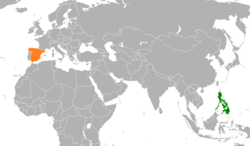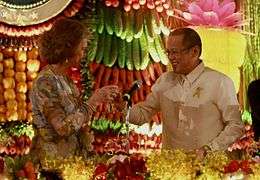Philippines–Spain relations
 | |
Philippines |
Spain |
|---|---|
| Diplomatic Mission | |
| Philippine Embassy, Madrid | Spanish Embassy, Manila |
| Envoy | |
| Ambassador Philippe Jones Lhuillier |
Ambassador Luis Antonio Calvo Castaño |
The Philippines–Spain relations (Filipino: Ugnayang Espanya at Pilipinas; Spanish: Relaciones entre España y Filipinas) is a bilateral and multilateral relations between the Philippines and Spain.
The Philippines was the lone colony of the Spanish Empire in Asia for more than three centuries. Spain has an embassy in Manila, and the Philippines has an embassy in Madrid. As of 2007, there are 115,362 Filipinos with dual citizenship. There are also 40,000 Filipinos residing in Spain who do not hold Spanish citizenship.[1] and an estimated 4,000 Spanish citizens residing in the Philippines.[2]
Country comparison
Leaders of the two states (1947–1981)

Leaders of the two states (1981–present)

History

The first Filipino settlement in Spain dates back to the Spanish colonial period of the Philippines between the 16th and 19th century. Today, Filipinos are one of the largest Asian communities in Spain, with a number of individuals obtaining Spanish citizenship. Most Filipinos in Spain work in various jobs and companies such as domestic and healthcare services, some individuals also work in education and government institutions.[5]
Bilateral relation
King Juan Carlos I and his wife Queen Sofia attended the 1998 centennial celebrations in Manila, commemorating 100 years of independence from Spain. The mediation of the Spanish King is said to have produced the pardon and liberation of 2 Filipina domestic workers sentenced to death in Kuwait and the United Arab Emirates. Former Philippine President Gloria Macapagal-Arroyo concluded her second state visit in Spain in July 2006, bringing back millions of dollars of Spanish investments, particularly in Tourism and Information Technology
Spanish Ambassador to the Philippines Jorge Domecq told the reporters that the "Philippines is the only country in Asia to receive more aid and development assistance from Spain than any other Asian country". He added that the Philippines remains a priority of the Spanish aid in development efforts and partnerships with the European Union, even despite budget cuts on development funding brought on by austerity measures being implemented by the Government of Spain.[6]
Former Spanish Minister José Bono Martínez assures that despite the economic crisis in Spain, it will continue to help and turn a "fraternal eye" on its former colony, the Philippines, during the launch of the 6th Tribuna España-Filipinas held on Makati City.[7]
Agreements
Spain and the Philippines have signed agreements aimed for boosting the two countries relations in sports, culture, and education, one of this agreement is the promotion, teaching and learning of the Spanish language in the Philippines.[8]
Friendship Day
The Philippine–Spanish Friendship Day was established on July 22, 2002. Republic Act No. 9187 was approved on February 5, 2003 as a means to strengthen the relationship between two nations that share history, values and traditions.
Republic Act No. 9187 states:
June 30 is a day when President Emilio Aguinaldo commended the besieged Spanish soldiers in the Church of Baler for their loyalty and gallantry. To mark this momentous occasion, there is a need to declare said day a national holiday to remember the act of benevolence which has paved the way in bridging better relations between Philippines and Spain.
The 30th of June of each year is hereby declared as Philippine-Spanish Friendship Day to commemorate the cultural and historical ties, friendship and cooperation between the Philippines and Spain. It is hereby declared as a national special working holiday and a special non-working holiday in Aurora Province.
Senator Edgardo Angara, the main promoter of the Friendship Day, described this occasion as, "a glorious day for both countries because the Siege of Baler brought heroes and victory for both parties. Today, it is the symbol of the great friendship between both countries.[9][10]
Queen Sofia's 2012 Visit

In July 2012, the Queen Sofia visited the Philippines for a fourth time. She inspected several development projects around the former Spanish colony that her country's government is funding via the Agencia Española de Cooperacion Internacional para el Desarollo (AECID). She visited the National Library, National Museum and the University of Santo Tomas. She also met with Spanish nationals residing in the Philippines, and attend a reception at the Spanish Embassy. She also attended a state dinner in her honour at Malacañan Palace hosted by President Benigno Aquino III.[11][12] Also during her visit in the former colony of her country, Queen Sofia expressed appreciation to Aquino for the country’s effort to reintroduce the Spanish language in the Philippine public education system and mentioned:[13]
| “ | It opens up opportunities to secure the well-being of future generations of Filipinos in the globalized world. | ” |
References
- ↑ Aurea Calica. "Spain Starts Hiring RP Health Workers". www.newsflash.org. Retrieved June 29, 2006.
- ↑ "Stock Estimate of Overseas Filipinos As of December 2009" (PDF). Philippine Overseas Employment Administration. Retrieved 2011-05-28.
- ↑ Literally President of the Government but formally known by English-speaking nations and formally translated by the European Commission Directorate-General in English as Prime Minister
- ↑ Being a constitutional monarchy, the government of Spain is headed by a prime minister but the official title in Spanish is Presidente del Gobierno, literally President of the Government. This can be confusing to foreigners and indeed is to many Spaniards, who sometimes translate the title into English as President. Therefore, the Spanish Vice President of the Government is actually the equivalent of a Deputy Prime Minister, not a Vice President.
- ↑ "Filipino Among Royal Guards of King of Spain". ABS CBN News. Retrieved July 2, 2009.
- ↑ "Philippines is only country in Asia to receive aid from Spain". InterAksyon. January 21, 2013.
- ↑ "Despite our own woes, Spain won't abandon you, ex-minister assures PH". Inquirer Global Nation. January 29, 2013.
- ↑ "Philippines, Spain ink 5 agreements". Inquirer Global Nation. October 25, 2012.
- ↑ "Baler recuerda a los 'últimos de Filipinas' en Día Amistad Hispano-filipina" [Baler remembers the "Last ones of the Philippines" in Philippine-Spanish Friendship Day] (in Spanish). Spain: Terra Noticias (noticias.terra.es). June 30, 2007. Archived from the original on July 20, 2010. Retrieved July 20, 2010.
- ↑ Congress of the Philippines (2003). "Republic Act No. 9187: An Act declaring June 30 of the year as Philippine-Spanish Friendship Day, appropriating funds therefor and for other purposes". Metro Manila, Philippines. Archived from the original (PDF) on July 15, 2010. Retrieved July 17, 2010.
- ↑ Archived August 13, 2012, at the Wayback Machine.
- ↑ "Albay gives Spanish queen warm welcome". Inquirer Global Nation. 5 July 2012.
- ↑ "PNoy and Spain's Queen Sofia welcome return of Spanish language in PHL schools". GMA News. July 3, 2012.

.svg.png)

